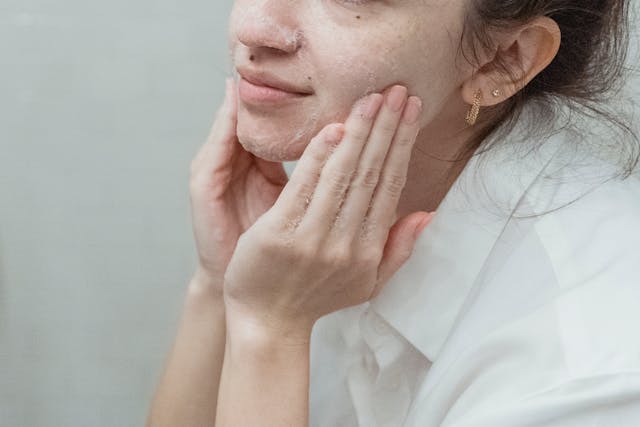Microneedling has quickly become a popular choice for achieving smoother, more radiant skin, delivering noticeable results with minimal downtime. However, if you have sensitive skin, it’s crucial to approach this treatment with extra caution to prevent any potential reactions or irritations.
Having sensitive skin doesn’t mean you can’t benefit from microneedling—it simply means you need to take extra care in preparing for the procedure. By taking the right steps beforehand, you can ensure a more comfortable experience and maximize the results.
Continue reading to discover how to get ready for microneedling if you have sensitive skin and set yourself up for a successful outcome.
Openly Communicate With Your Provider
Sensitive skin can respond unpredictably to microneedling, so it’s important to have a clear and open dialogue with your provider before the treatment. Providing them with detailed information helps them tailor the procedure to suit your skin’s unique needs.
To ensure a safe and effective session, consider discussing the following key points during your consultation:
- Share your complete skin history: Inform your provider about past treatments, allergies, or any previous skin reactions, no matter how minor they may seem. This information gives them valuable insight into potential triggers and helps prevent unexpected skin issues.
- Discuss any current skin conditions: If you are dealing with concerns like acne scars, rosacea, or heightened skin sensitivity, be sure to mention them directly. These factors can influence the depth and intensity of the microneedling treatment chosen by your provider.
- Inquire about specialized techniques for sensitive skin: Some estheticians utilize specific approaches or settings for delicate skin types. Asking about their methods in advance can help you feel more confident in the treatment process.
For the best results, consider seeking microneedling treatment from a certified esthetician in a modern clinical setting. Choose a provider who is knowledgeable about sensitive skin and customizes treatments to suit your specific skin type.
Steer Clear of Harsh Skincare Products Before Your Session
In the days leading up to your microneedling appointment, focus on maintaining a calm and balanced environment for your sensitive skin. Harsh products can disrupt your skin’s barrier, potentially leading to irritation during or after the treatment.
Here are the products and ingredients to avoid prior to your microneedling session:
- Refrain from using retinoids and chemical exfoliants: Ingredients such as retinol, glycolic acid, and salicylic acid can thin the skin’s outer layer and increase its reactivity. Pause the use of these products at least 3–5 days before the treatment to help maintain your skin’s integrity.
- Avoid foaming and astringent cleansers: These cleansers often contain harsh chemicals that can strip the skin of its natural moisture. Opt for a gentle, non-foaming cleanser that won’t disrupt your skin’s balance.
- Steer clear of makeup removers with alcohol: Products containing high levels of alcohol can dry out and sensitize the skin. Switch to an oil-based or micellar cleanser that can remove makeup without causing irritation.
By giving your skin a break from harsh products, you can reduce the risk of irritation and ensure that your skin remains calm and well-prepared for the microneedling treatment.
Maintain Optimal Skin Hydration
Proper hydration is essential for skin health, especially when preparing for microneedling. This step helps support your skin’s resilience, reducing the likelihood of irritation and enhancing the overall effectiveness of the treatment.
Here are some key hydration tips to keep in mind:
- Opt for a moisturizer that boosts your skin’s barrier: Look for products containing ceramides, glycerin, and hyaluronic acid, which help strengthen your skin’s natural barrier. These ingredients lock in moisture and create a protective layer, making your skin less susceptible to irritation during the procedure.
- Apply moisturizer morning and night: Consistent moisturization helps maintain adequate hydration levels, keeping your skin smooth and supple. Regular use ensures that your skin is well-prepared to handle the minor trauma associated with microneedling, promoting better healing post-treatment.
- Stay hydrated internally: Drinking plenty of water throughout the day is just as important as topical moisturization. Adequate hydration supports skin elasticity and can reduce the risk of skin dryness or irritation during the treatment.
Maintaining skin hydration creates a balanced environment that supports the microneedling process and facilitates post-treatment recovery.
Minimize Sun Exposure and Avoid Tanning
Sensitive skin can be more susceptible to UV damage, making it vital to shield your skin before undergoing microneedling. Exposure to direct sunlight or tanning can heighten the risk of irritation, hyperpigmentation, and impede your skin’s healing process.
Follow these essential steps:
- Avoid prolonged sun exposure: Steer clear of direct sunlight for at least 3-5 days leading up to the procedure. UV rays can cause damage that may exacerbate irritation during and after microneedling.
- Do not use tanning beds or self-tanners: Tanning beds and self-tanning products can compromise your skin’s health and lead to uneven pigmentation, increasing sensitivity.
- Apply sunscreen daily: Use a mineral sunscreen with SPF 30 or higher, even if you are indoors most of the time. Sun protection helps reduce inflammation and accelerates post-treatment recovery.
By safeguarding your skin from the sun before microneedling, you can preserve its integrity and enhance its ability to heal effectively, resulting in optimal outcomes.
In Conclusion
Microneedling remains a viable option for individuals with sensitive skin—you just need to prepare appropriately. By avoiding harsh ingredients, maintaining skin hydration, protecting your skin from the sun, and collaborating closely with your provider, you can ensure a successful and comfortable experience. With these precautionary measures in place, you can enjoy smoother, healthier skin with minimal irritation.

